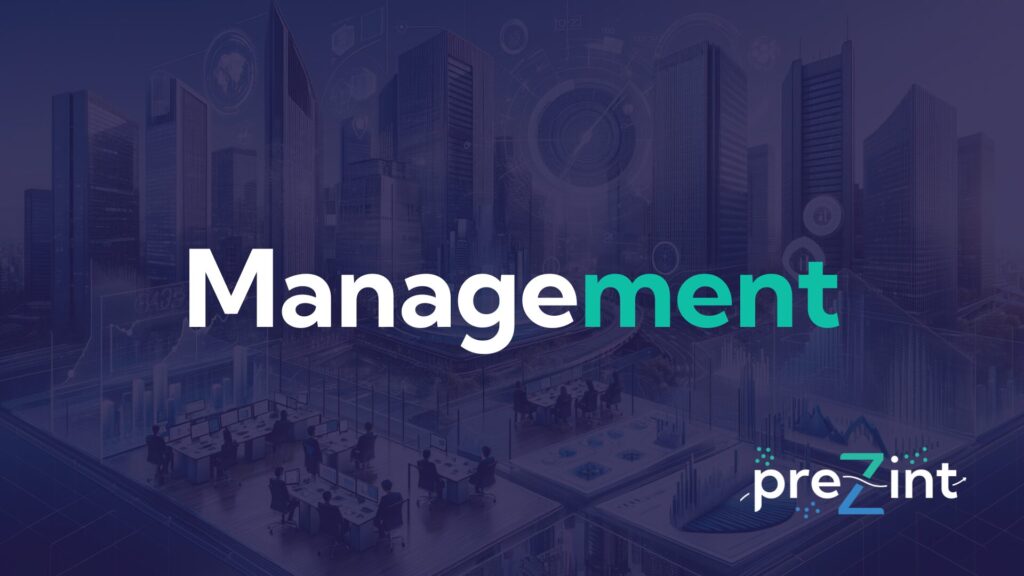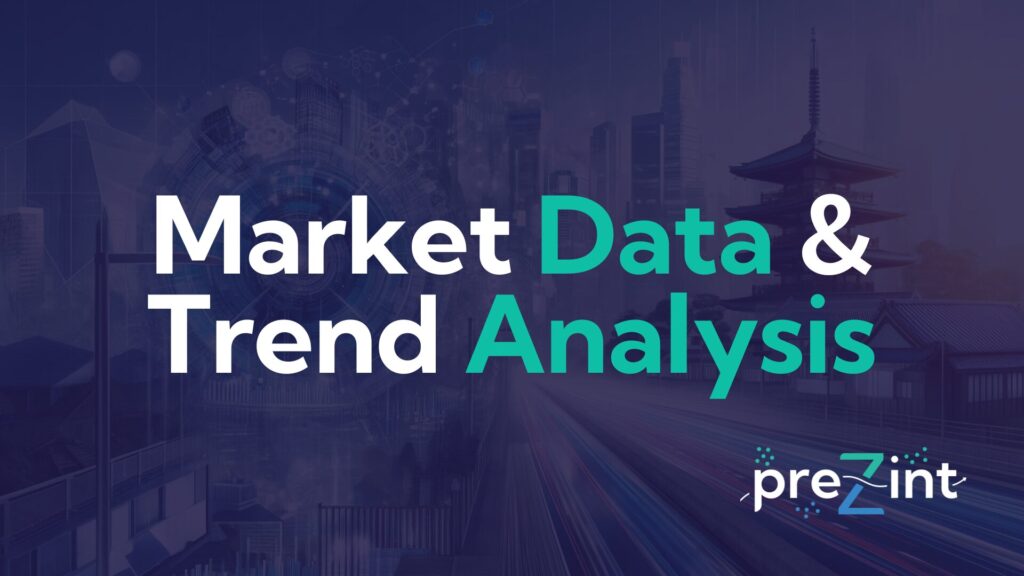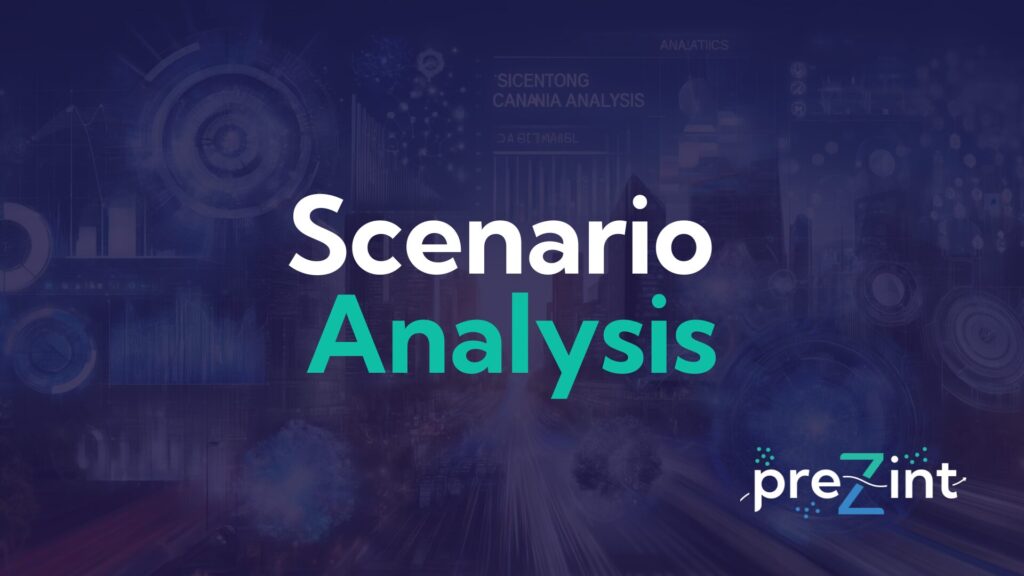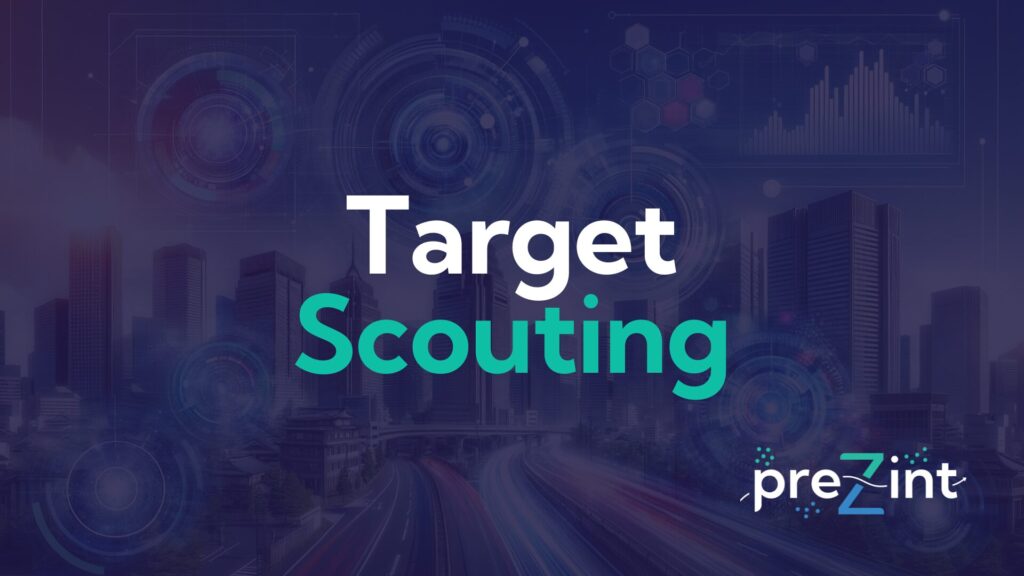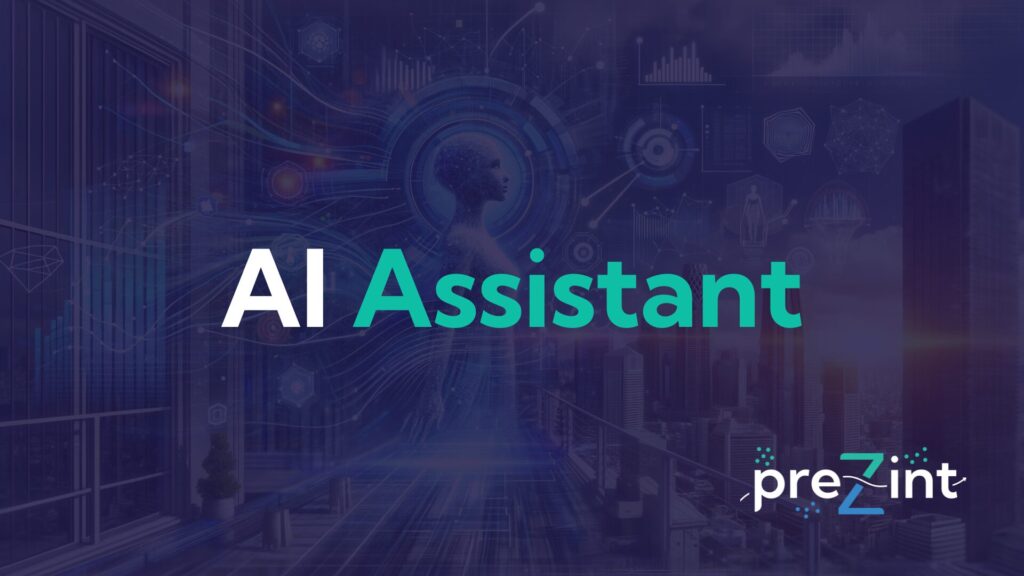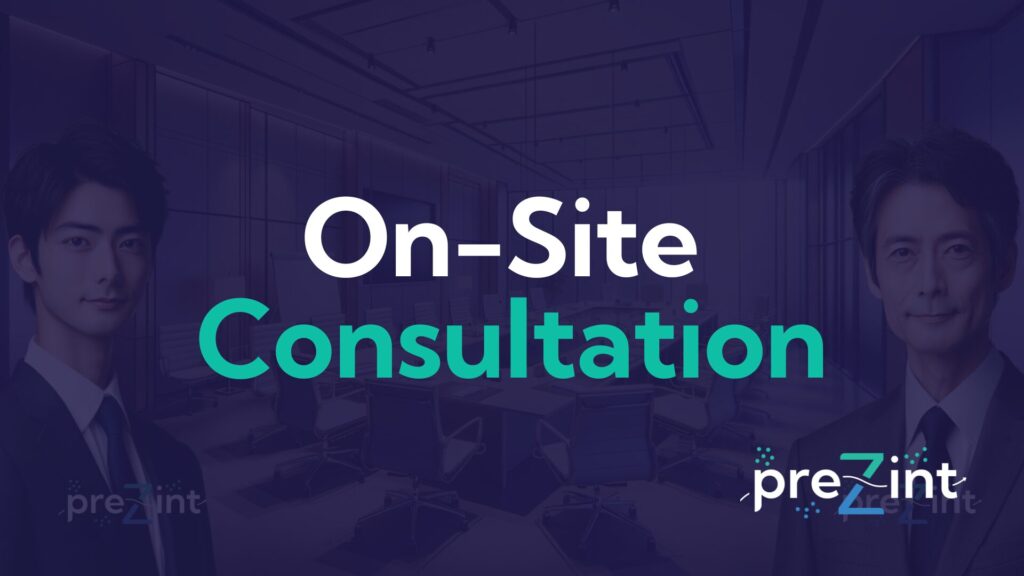Elevating Management
With preZint
In today’s fast-paced and competitive business environment,
executive teams in Japan face many critical challenges.
executive teams in Japan face many critical challenges.
preZint offers a powerful solution designed to streamline
management processes, enhance data reliability, and
speed up decision-making.
management processes, enhance data reliability, and
speed up decision-making.
Key Challenges Faced
By Management
Data Integration Challenges For
Executive Decisions
Navigating data integration complexities is a significant challenge
for executives who need comprehensive and timely insights to
drive strategic decisions.
for executives who need comprehensive and timely insights to
drive strategic decisions.
Fragmented Systems: Many organizations use separate systems
for different functions, such as ERP systems for operational data
and CRM systems for customer information. This fragmentation
can hinder executives from getting a comprehensive view of
company performance. For instance, an executive needs to make
a decision on resource allocation across departments but finds that
financial data is in one system while project timelines and customer
feedback are in others. This separation makes it difficult to quickly
correlate data points and understand the full picture.
for different functions, such as ERP systems for operational data
and CRM systems for customer information. This fragmentation
can hinder executives from getting a comprehensive view of
company performance. For instance, an executive needs to make
a decision on resource allocation across departments but finds that
financial data is in one system while project timelines and customer
feedback are in others. This separation makes it difficult to quickly
correlate data points and understand the full picture.
Manual Data Aggregation: Executives often rely on manual
processes to compile data from various sources, which is
time-consuming and error-prone. For example, during a
quarterly business review, an executive might need to pull
together sales reports, financial statements, and market
analysis from different systems. This manual aggregation can
take days and is prone to errors, delaying important decisions
and potentially leading to inaccuracies.
processes to compile data from various sources, which is
time-consuming and error-prone. For example, during a
quarterly business review, an executive might need to pull
together sales reports, financial statements, and market
analysis from different systems. This manual aggregation can
take days and is prone to errors, delaying important decisions
and potentially leading to inaccuracies.
Legacy Systems: Many enterprises still use outdated legacy
systems that do not integrate well with newer technologies.
These systems can create data silos that impede the flow of
information. For example, a company might use an old financial
management system that cannot integrate with modern CRM
or supply chain management systems. This incompatibility can
prevent the executive team from getting real-time updates and
comprehensive analytics needed for strategic planning.
systems that do not integrate well with newer technologies.
These systems can create data silos that impede the flow of
information. For example, a company might use an old financial
management system that cannot integrate with modern CRM
or supply chain management systems. This incompatibility can
prevent the executive team from getting real-time updates and
comprehensive analytics needed for strategic planning.
These scenarios highlight the need for effective data integration
solutions that can provide executives with a real-time, unified
view of their organization’s data, enabling more informed and
timely decision-making.
solutions that can provide executives with a real-time, unified
view of their organization’s data, enabling more informed and
timely decision-making.
Regulatory Compliance
Ensuring regulatory compliance is a critical and complex task for
executives, particularly in large enterprises that operate across
multiple jurisdictions. Here are some key challenges faced in this
area:
executives, particularly in large enterprises that operate across
multiple jurisdictions. Here are some key challenges faced in this
area:
Evolving Regulatory Landscapes: Executives must stay abreast of
constantly changing regulations that affect their industry. For
instance, a new data privacy law might be enacted in one of the
countries where the company operates. The executive team must
ensure that all data handling practices comply with this new regulation,
which requires a thorough review and potential overhaul of existing
processes. This constant evolution necessitates a proactive approach
to monitor and implement changes swiftly.
constantly changing regulations that affect their industry. For
instance, a new data privacy law might be enacted in one of the
countries where the company operates. The executive team must
ensure that all data handling practices comply with this new regulation,
which requires a thorough review and potential overhaul of existing
processes. This constant evolution necessitates a proactive approach
to monitor and implement changes swiftly.
Geopolitical Risks: Geopolitical changes can have a significant impact
on regulatory requirements. For example, trade tensions between
major economies might lead to the introduction of new tariffs or
sanctions. An executive must be prepared to quickly assess how
these changes affect their supply chain and make necessary
adjustments to avoid legal repercussions and minimize business
disruptions. This scenario demands a robust system for real-time
monitoring and analysis of geopolitical events.
on regulatory requirements. For example, trade tensions between
major economies might lead to the introduction of new tariffs or
sanctions. An executive must be prepared to quickly assess how
these changes affect their supply chain and make necessary
adjustments to avoid legal repercussions and minimize business
disruptions. This scenario demands a robust system for real-time
monitoring and analysis of geopolitical events.
Cross-Border Compliance: Companies operating globally must
comply with regulations in each country where they do business.
An executive managing a multinational corporation might face
different labor laws, environmental regulations, and tax requirements
in each jurisdiction. For instance, while ensuring compliance with the
European Union’s stringent environmental standards, they must also
navigate the complex regulatory framework in emerging markets.
This diversity in regulations requires comprehensive compliance
strategies and systems capable of handling diverse regulatory
requirements.
comply with regulations in each country where they do business.
An executive managing a multinational corporation might face
different labor laws, environmental regulations, and tax requirements
in each jurisdiction. For instance, while ensuring compliance with the
European Union’s stringent environmental standards, they must also
navigate the complex regulatory framework in emerging markets.
This diversity in regulations requires comprehensive compliance
strategies and systems capable of handling diverse regulatory
requirements.
Compliance Reporting: Executives are responsible for generating
and submitting detailed compliance reports to regulatory bodies.
This process can be particularly challenging when data is spread
across multiple departments and systems. For example, producing
an annual sustainability report might require data from manufacturing,
procurement, and HR departments, each using different systems and
formats. Aggregating this data manually can be time-consuming and
error-prone, leading to delays and inaccuracies in reporting.
and submitting detailed compliance reports to regulatory bodies.
This process can be particularly challenging when data is spread
across multiple departments and systems. For example, producing
an annual sustainability report might require data from manufacturing,
procurement, and HR departments, each using different systems and
formats. Aggregating this data manually can be time-consuming and
error-prone, leading to delays and inaccuracies in reporting.
Risk of Non-Compliance: The consequences of non-compliance can
be severe, including hefty fines, legal actions, and damage to the
company’s reputation. For example, if a company fails to comply
with new financial regulations, it might face significant fines and
legal challenges. This potential risk underscores the need for
real-time compliance monitoring and proactive management
to ensure that the company meets all regulatory requirements
consistently.
be severe, including hefty fines, legal actions, and damage to the
company’s reputation. For example, if a company fails to comply
with new financial regulations, it might face significant fines and
legal challenges. This potential risk underscores the need for
real-time compliance monitoring and proactive management
to ensure that the company meets all regulatory requirements
consistently.
These scenarios illustrate the importance of having robust systems
and strategies in place to navigate the complex regulatory landscape
effectively, ensuring that executives can lead their organizations with
confidence and integrity.
and strategies in place to navigate the complex regulatory landscape
effectively, ensuring that executives can lead their organizations with
confidence and integrity.
Market Volatility
Market volatility presents significant challenges for executives who
must navigate rapid and unpredictable changes to safeguard their
organizations. Here are the key issues faced in this area:
must navigate rapid and unpredictable changes to safeguard their
organizations. Here are the key issues faced in this area:
Unpredictable Economic Conditions: Executives often face sudden
shifts in economic conditions that can disrupt business operations.
For example, an unexpected change in interest rates or a sudden
economic downturn can lead to decreased consumer spending and
impact revenue projections. Executives must be prepared to adjust
their strategies swiftly to mitigate the effects of such economic
changes.
shifts in economic conditions that can disrupt business operations.
For example, an unexpected change in interest rates or a sudden
economic downturn can lead to decreased consumer spending and
impact revenue projections. Executives must be prepared to adjust
their strategies swiftly to mitigate the effects of such economic
changes.
Impact of Global Events: Global events such as political instability,
natural disasters, or pandemics can create volatility in the market.
An executive managing a global supply chain might have to deal
with disruptions caused by a natural disaster in a key supplier’s
country or adjust to the impact of a global pandemic on workforce
availability and consumer demand. These events require quick
decision-making and the ability to pivot strategies to maintain
business continuity.
natural disasters, or pandemics can create volatility in the market.
An executive managing a global supply chain might have to deal
with disruptions caused by a natural disaster in a key supplier’s
country or adjust to the impact of a global pandemic on workforce
availability and consumer demand. These events require quick
decision-making and the ability to pivot strategies to maintain
business continuity.
Fluctuations in Commodity Prices: For industries reliant on raw
materials, fluctuations in commodity prices can significantly affect
cost structures and profitability. For example, an executive in the
manufacturing sector must constantly monitor changes in the prices
of raw materials like steel or oil. Sudden price increases can erode
profit margins, necessitating the need for forward contracts or
alternative sourcing strategies.
materials, fluctuations in commodity prices can significantly affect
cost structures and profitability. For example, an executive in the
manufacturing sector must constantly monitor changes in the prices
of raw materials like steel or oil. Sudden price increases can erode
profit margins, necessitating the need for forward contracts or
alternative sourcing strategies.
Currency Exchange Rate Volatility: Companies operating in multiple
countries must manage the risks associated with fluctuating currency
exchange rates. An executive overseeing international operations might
face challenges when a strong domestic currency reduces the
competitiveness of exports or when a weaker foreign currency increases
the cost of importing goods. Hedging strategies and financial instruments
are often used to mitigate these risks.
countries must manage the risks associated with fluctuating currency
exchange rates. An executive overseeing international operations might
face challenges when a strong domestic currency reduces the
competitiveness of exports or when a weaker foreign currency increases
the cost of importing goods. Hedging strategies and financial instruments
are often used to mitigate these risks.
Investor Sentiment and Stock Market Movements: Changes in investor
sentiment can lead to stock market volatility, impacting a company’s
market valuation and investor confidence. Executives must manage
communication with shareholders and analysts to navigate the effects
of market sentiment on the company’s stock price. For instance, negative
media coverage or an unexpected earnings report can lead to significant
stock price movements, requiring immediate strategic responses.
sentiment can lead to stock market volatility, impacting a company’s
market valuation and investor confidence. Executives must manage
communication with shareholders and analysts to navigate the effects
of market sentiment on the company’s stock price. For instance, negative
media coverage or an unexpected earnings report can lead to significant
stock price movements, requiring immediate strategic responses.
These scenarios illustrate the importance of having robust risk
management strategies and tools in place. By understanding and
anticipating market volatility, executives can make informed decisions
to protect their organizations and capitalize on emerging opportunities.
management strategies and tools in place. By understanding and
anticipating market volatility, executives can make informed decisions
to protect their organizations and capitalize on emerging opportunities.
Growing Revenue
Effective revenue growth strategies are vital for maintaining a
competitive edge and ensuring long-term success. Executives
face several key challenges in this area that require strategic
attention and solutions:
competitive edge and ensuring long-term success. Executives
face several key challenges in this area that require strategic
attention and solutions:
Market Expansion and Penetration: In a dynamic market, expanding
into new territories and increasing market share are persistent challenges.
Executives must develop comprehensive market entry strategies,
including competitive analysis, local partnerships, and tailored marketing
campaigns. For instance, a distributor might struggle to enter an emerging
market due to regulatory barriers and local competition. This necessitates a
well-researched entry strategy, robust local alliances, and adaptability to
local consumer preferences and legal requirements.
into new territories and increasing market share are persistent challenges.
Executives must develop comprehensive market entry strategies,
including competitive analysis, local partnerships, and tailored marketing
campaigns. For instance, a distributor might struggle to enter an emerging
market due to regulatory barriers and local competition. This necessitates a
well-researched entry strategy, robust local alliances, and adaptability to
local consumer preferences and legal requirements.
Product and Service Innovation: Keeping up with market trends and
technological advancements is crucial for maintaining a competitive
product portfolio. For example, a manufacturing company may need
to rapidly develop new features or products to meet evolving customer
demands and stay ahead of technological advancements. This is
particularly important in sectors like automotive or electronics, where
consumer preferences and technology evolve rapidly. Executives must
invest in R&D and foster a culture of innovation to stay competitive,
ensuring that new product developments align with market needs and
technological trends.
technological advancements is crucial for maintaining a competitive
product portfolio. For example, a manufacturing company may need
to rapidly develop new features or products to meet evolving customer
demands and stay ahead of technological advancements. This is
particularly important in sectors like automotive or electronics, where
consumer preferences and technology evolve rapidly. Executives must
invest in R&D and foster a culture of innovation to stay competitive,
ensuring that new product developments align with market needs and
technological trends.
Customer Acquisition and Retention: Attracting and retaining customers
in a saturated market requires strategic marketing and customer
engagement initiatives. For example, a finance firm might face challenges
in retaining clients due to aggressive competition and evolving customer
expectations. This requires creating compelling value propositions and
personalized customer experiences through enhanced loyalty programs
and targeted marketing efforts to maintain customer engagement and
satisfaction.
in a saturated market requires strategic marketing and customer
engagement initiatives. For example, a finance firm might face challenges
in retaining clients due to aggressive competition and evolving customer
expectations. This requires creating compelling value propositions and
personalized customer experiences through enhanced loyalty programs
and targeted marketing efforts to maintain customer engagement and
satisfaction.
Pricing Strategy and Revenue Models: Determining optimal pricing
strategies and revenue models can significantly impact profitability.
Executives need to analyze market conditions, competitor pricing,
and customer willingness to pay. For instance, a manufacturing firm
might need to adjust its pricing strategy for a new product line based
on detailed market feedback and competitor analysis. This involves
conducting thorough market research, understanding cost structures,
and implementing dynamic pricing models that can adapt to changing
market dynamics.
strategies and revenue models can significantly impact profitability.
Executives need to analyze market conditions, competitor pricing,
and customer willingness to pay. For instance, a manufacturing firm
might need to adjust its pricing strategy for a new product line based
on detailed market feedback and competitor analysis. This involves
conducting thorough market research, understanding cost structures,
and implementing dynamic pricing models that can adapt to changing
market dynamics.
Sales Optimization and Performance: Ensuring an efficient and
high-performing sales team is crucial for driving revenue growth.
For example, a manufacturing company may need to enhance its
sales operations by integrating advanced analytics to identify
high-potential leads and optimize sales pitches. This might involve
implementing a sophisticated lead scoring system, refining sales
training programs to focus on high-impact selling techniques, and
continuously analyzing sales data to identify areas for improvement
and tailor strategies accordingly.
high-performing sales team is crucial for driving revenue growth.
For example, a manufacturing company may need to enhance its
sales operations by integrating advanced analytics to identify
high-potential leads and optimize sales pitches. This might involve
implementing a sophisticated lead scoring system, refining sales
training programs to focus on high-impact selling techniques, and
continuously analyzing sales data to identify areas for improvement
and tailor strategies accordingly.
Strategic Partnerships and Alliances: Forming strategic partnerships
and alliances can open new revenue streams and enhance market
presence. For example, a finance firm might partner with industry-specific
data providers to integrate detailed financial analytics into their service
offerings, providing clients with deeper insights and more comprehensive
solutions. This involves identifying potential partners who offer
complementary services, negotiating mutually beneficial agreements, and
continuously managing these relationships to ensure long-term success.
and alliances can open new revenue streams and enhance market
presence. For example, a finance firm might partner with industry-specific
data providers to integrate detailed financial analytics into their service
offerings, providing clients with deeper insights and more comprehensive
solutions. This involves identifying potential partners who offer
complementary services, negotiating mutually beneficial agreements, and
continuously managing these relationships to ensure long-term success.
These scenarios highlight the multifaceted challenges executives face
in driving revenue growth. Addressing these issues requires a strategic
approach, leveraging technology, fostering a culture of innovation,
and ensuring data-driven decision-making to create a resilient and
high-performing business.
in driving revenue growth. Addressing these issues requires a strategic
approach, leveraging technology, fostering a culture of innovation,
and ensuring data-driven decision-making to create a resilient and
high-performing business.
How preZint
Supports Mangement
Data Integration Challenges For
Executive Decisions
Solution: PreZint provides on-site assistance, ensuring seamless
integration of diverse data sources with minimal effort required
from the enterprise. This includes ERP systems, CRM systems,
MES, QMS, IoT devices, and much more, tailored to the specific
needs of the enterprise to solve unique problems. Our personnel
handle the entire integration process, ensuring it is customized to
address very specific challenges.
integration of diverse data sources with minimal effort required
from the enterprise. This includes ERP systems, CRM systems,
MES, QMS, IoT devices, and much more, tailored to the specific
needs of the enterprise to solve unique problems. Our personnel
handle the entire integration process, ensuring it is customized to
address very specific challenges.
Benefit: Executives can obtain any type of insight, KPI, or report
that requires combined data from various departments or sources
within minutes. This eliminates the need to manually compile data
from different places, significantly reducing the time and effort
required to create comprehensive reports. The platform also allows
secure sharing of these reports with user access controls, enabling
faster and more informed decision-making.
that requires combined data from various departments or sources
within minutes. This eliminates the need to manually compile data
from different places, significantly reducing the time and effort
required to create comprehensive reports. The platform also allows
secure sharing of these reports with user access controls, enabling
faster and more informed decision-making.
Example: A manufacturing company uses preZint to aggregate data
from production schedules, quality control metrics, and equipment
status across multiple production lines. With preZint, the company can
quickly generate comprehensive reports on key performance indicators
such as cycle time, downtime, and defect rates. This unified view allows the
manufacturing team to identify potential production bottlenecks and
optimize processes more efficiently, using terms like OEE (Overall
Equipment Effectiveness), takt time, and Six Sigma metrics to ensure
continuous improvement and operational excellence.
from production schedules, quality control metrics, and equipment
status across multiple production lines. With preZint, the company can
quickly generate comprehensive reports on key performance indicators
such as cycle time, downtime, and defect rates. This unified view allows the
manufacturing team to identify potential production bottlenecks and
optimize processes more efficiently, using terms like OEE (Overall
Equipment Effectiveness), takt time, and Six Sigma metrics to ensure
continuous improvement and operational excellence.
Regulatory Compliance
Solution: preZint connects to the internet, including search engines,
SNS, forums, and many other digital mediums. These connections ensure
that preZint is updated instantly as these digital mediums update,
providing real-time data integration. This makes preZint a powerful tool
for regulatory compliance, fully customizable to give notifications when
regulatory changes occur from any country or region. Additionally, preZint
can output predictive notifications when it identifies the possibility of regulatory
changes, offering customization for any specified region or country.
SNS, forums, and many other digital mediums. These connections ensure
that preZint is updated instantly as these digital mediums update,
providing real-time data integration. This makes preZint a powerful tool
for regulatory compliance, fully customizable to give notifications when
regulatory changes occur from any country or region. Additionally, preZint
can output predictive notifications when it identifies the possibility of regulatory
changes, offering customization for any specified region or country.
Benefit: This real-time and predictive capability significantly reduces the
resources allocated to researchers who monitor regulatory changes. By
predicting regulatory changes beforehand, executives can adopt a proactive
approach to compliance, ensuring that the organization remains ahead of
regulatory requirements and avoids potential fines or disruptions.
resources allocated to researchers who monitor regulatory changes. By
predicting regulatory changes beforehand, executives can adopt a proactive
approach to compliance, ensuring that the organization remains ahead of
regulatory requirements and avoids potential fines or disruptions.
Example: A manufacturing firm facing the implementation of new
environmental regulations uses PreZint to simulate the impact of these
changes on their production processes. By leveraging PreZint’s scenario
analysis feature, the firm forecasts potential hidden costs, such as increased
energy consumption or waste disposal fees, which would otherwise not have
been known. For instance, the scenario analysis reveals that upgrading to
more efficient equipment to meet new emission standards will increase initial
capital expenditure but save substantial operational costs in the long run. This
enables the firm to choose the most cost-effective compliance strategy, ensuring
adherence to regulations without unnecessary expenditures or disruptions to
production.
environmental regulations uses PreZint to simulate the impact of these
changes on their production processes. By leveraging PreZint’s scenario
analysis feature, the firm forecasts potential hidden costs, such as increased
energy consumption or waste disposal fees, which would otherwise not have
been known. For instance, the scenario analysis reveals that upgrading to
more efficient equipment to meet new emission standards will increase initial
capital expenditure but save substantial operational costs in the long run. This
enables the firm to choose the most cost-effective compliance strategy, ensuring
adherence to regulations without unnecessary expenditures or disruptions to
production.
Market Volatility
Solution: Due to preZint having access to data from 1,500,000 global
companies, being trained on 1 billion months of financial and business
data, and being connected to various digital mediums like SNS, search
engines, and more, preZint integrates a vast array of data sources that
are updated literally every minute, sometimes even less. This constant
influx of up-to-date information allows preZint to run numerous scenario
analyses swiftly, each taking minutes instead of weeks or months. Previously
impractical simulations due to time constraints are now feasible, enabling the
execution of multiple high-quality simulations. Imagine running your preferred
simulations in minutes; the accuracy and timeliness of your decision-making
would significantly improve.
companies, being trained on 1 billion months of financial and business
data, and being connected to various digital mediums like SNS, search
engines, and more, preZint integrates a vast array of data sources that
are updated literally every minute, sometimes even less. This constant
influx of up-to-date information allows preZint to run numerous scenario
analyses swiftly, each taking minutes instead of weeks or months. Previously
impractical simulations due to time constraints are now feasible, enabling the
execution of multiple high-quality simulations. Imagine running your preferred
simulations in minutes; the accuracy and timeliness of your decision-making
would significantly improve.
Benefit: The primary benefit is that executives can make rapid, well-informed
decisions. Consider a recent negotiation where having a specific insight at the
critical moment could have provided significant leverage. Or think of a trade
you didn’t execute because you couldn’t obtain the necessary risk reports
promptly, as you were waiting for data from various departments. preZint
eliminates these delays by providing real-time, comprehensive insights, thus
enhancing decision-making speed and accuracy.
decisions. Consider a recent negotiation where having a specific insight at the
critical moment could have provided significant leverage. Or think of a trade
you didn’t execute because you couldn’t obtain the necessary risk reports
promptly, as you were waiting for data from various departments. preZint
eliminates these delays by providing real-time, comprehensive insights, thus
enhancing decision-making speed and accuracy.
Example: A financial firm uses preZint to hedge its investments ahead of an
upcoming Federal Reserve meeting. By running multiple scenario analyses
based on real-time data from global financial markets, SNS, and other digital
mediums, the firm can quickly assess potential outcomes and adjust its strategies
accordingly. For instance, preZint’s simulations reveal that a potential interest rate
hike could impact certain asset classes, prompting the firm to reallocate its
portfolio to mitigate risks. This proactive approach ensures the firm remains
well-prepared and can capitalize on emerging opportunities, maintaining a
competitive edge in a volatile market.
upcoming Federal Reserve meeting. By running multiple scenario analyses
based on real-time data from global financial markets, SNS, and other digital
mediums, the firm can quickly assess potential outcomes and adjust its strategies
accordingly. For instance, preZint’s simulations reveal that a potential interest rate
hike could impact certain asset classes, prompting the firm to reallocate its
portfolio to mitigate risks. This proactive approach ensures the firm remains
well-prepared and can capitalize on emerging opportunities, maintaining a
competitive edge in a volatile market.
Growing Revenue
Solution: With preZint’s database of 1,500,000 global companies and
25,000,000 data points per company, coupled with its integration with
numerous external digital mediums, preZint positions itself as the ultimate
tool for global market data and trends. This comprehensive database allows
enterprises to benchmark themselves against competitors, observe global
trends in various marketplaces, and gain insights that can inspire new initiatives
and projects. Additionally, preZint can showcase whether current KPIs are
meeting industry standards. It also includes a tool that can recommend whether
to develop new products in-house or acquire existing companies. preZint’s
end-to-end M&A features, such as target scouting, enable enterprises to find
potential acquisition targets or vet partnerships like suppliers. This feature
provides similarity matching scores relative to the enterprise’s initiatives, along
with the reasoning behind these scores. Users can create shortlists and utilize
preZint as a private, secure data room for further due diligence, incorporating
scenario analyses and more.
25,000,000 data points per company, coupled with its integration with
numerous external digital mediums, preZint positions itself as the ultimate
tool for global market data and trends. This comprehensive database allows
enterprises to benchmark themselves against competitors, observe global
trends in various marketplaces, and gain insights that can inspire new initiatives
and projects. Additionally, preZint can showcase whether current KPIs are
meeting industry standards. It also includes a tool that can recommend whether
to develop new products in-house or acquire existing companies. preZint’s
end-to-end M&A features, such as target scouting, enable enterprises to find
potential acquisition targets or vet partnerships like suppliers. This feature
provides similarity matching scores relative to the enterprise’s initiatives, along
with the reasoning behind these scores. Users can create shortlists and utilize
preZint as a private, secure data room for further due diligence, incorporating
scenario analyses and more.
Benefit: Executives will never be lost for future initiatives that could play a
vital role in market expansion or penetration. preZint enables proactive
strategic planning by providing clear insights and actionable recommendations.
Example: A manufacturing firm looking to expand its product line and
enter new markets uses preZint to analyze global trends and benchmark
against competitors. The platform reveals that a particular type of
eco-friendly product is gaining significant traction in European markets.
preZint’s recommendation tool suggests acquiring a small, innovative
company in Europe that specializes in this product type. Using the target
scouting feature, the firm identifies several potential acquisition targets and
uses the similarity matching scores to shortlist the best candidates. preZint
then serves as a secure data room for conducting due diligence on these
targets, incorporating scenario analyses to forecast potential outcomes and
hidden costs. This comprehensive approach enables the firm to make an
informed decision, ultimately acquiring a company that aligns perfectly with
its strategic goals and market expansion plans.
enter new markets uses preZint to analyze global trends and benchmark
against competitors. The platform reveals that a particular type of
eco-friendly product is gaining significant traction in European markets.
preZint’s recommendation tool suggests acquiring a small, innovative
company in Europe that specializes in this product type. Using the target
scouting feature, the firm identifies several potential acquisition targets and
uses the similarity matching scores to shortlist the best candidates. preZint
then serves as a secure data room for conducting due diligence on these
targets, incorporating scenario analyses to forecast potential outcomes and
hidden costs. This comprehensive approach enables the firm to make an
informed decision, ultimately acquiring a company that aligns perfectly with
its strategic goals and market expansion plans.
Conclusion
preZint plays a critical role in supporting the management division
of enterprises by providing a comprehensive, data-driven approach
to decision-making.
of enterprises by providing a comprehensive, data-driven approach
to decision-making.
By centralizing data, enhancing analytics, improving collaboration,
supporting strategic planning, and managing risks, preZint empowers
the management division to lead the enterprise towards sustained
growth and success.
supporting strategic planning, and managing risks, preZint empowers
the management division to lead the enterprise towards sustained
growth and success.
Next Steps
Book a demo today to see how preZint can transform your
management processes and drive your enterprise forward.
management processes and drive your enterprise forward.
Elevating Management
With preZint
In today’s fast-paced and competitive business environment, executive teams in Japan face several critical challenges:
preZint offers a powerful solution designed to streamline management processes, enhance data reliability, and
speed up decision-making.
Key Challenges For Management
Data Integration Challenges For Executive Decisions
Navigating data integration complexities is a significant challenge for executives who need comprehensive and timely insights to
drive strategic decisions.
Fragmented Systems: Many organizations use separate systems for different functions, such as ERP systems for operational data
and CRM systems for customer information. This fragmentation
can hinder executives from getting a comprehensive view of
company performance. For instance, an executive needs to make
a decision on resource allocation across departments but finds that
financial data is in one system while project timelines and customer
feedback are in others. This separation makes it difficult to quickly
correlate data points and understand the full picture.
Manual Data Aggregation: Executives often rely on manual processes to compile data from various sources, which is
time-consuming and error-prone. For example, during a
quarterly business review, an executive might need to pull
together sales reports, financial statements, and market
analysis from different systems. This manual aggregation can
take days and is prone to errors, delaying important decisions
and potentially leading to inaccuracies.
Legacy Systems: Many enterprises still use outdated legacy systems that do not integrate well with newer technologies.
These systems can create data silos that impede the flow of
information. For example, a company might use an old financial
management system that cannot integrate with modern CRM
or supply chain management systems. This incompatibility can
prevent the executive team from getting real-time updates and
comprehensive analytics needed for strategic planning.
These scenarios highlight the need for effective data integration solutions that can provide executives with a real-time, unified
view of their organization’s data, enabling more informed and
timely decision-making.
Regulatory Compliance
Ensuring regulatory compliance is a critical and complex task for executives, particularly in large enterprises that operate across
multiple jurisdictions. Here are some key challenges faced in this
area:
Evolving Regulatory Landscapes: Executives must stay abreast of constantly changing regulations that affect their industry. For
instance, a new data privacy law might be enacted in one of the
countries where the company operates. The executive team must
ensure that all data handling practices comply with this new regulation,
which requires a thorough review and potential overhaul of existing
processes. This constant evolution necessitates a proactive approach
to monitor and implement changes swiftly.
Geopolitical Risks: Geopolitical changes can have a significant impact
on regulatory requirements. For example, trade tensions between major economies might lead to the introduction of new tariffs or
sanctions. An executive must be prepared to quickly assess how
these changes affect their supply chain and make necessary
adjustments to avoid legal repercussions and minimize business
disruptions. This scenario demands a robust system for real-time
monitoring and analysis of geopolitical events.
Cross-Border Compliance: Companies operating globally must comply with regulations in each country where they do business.
An executive managing a multinational corporation might face
different labor laws, environmental regulations, and tax requirements
in each jurisdiction. For instance, while ensuring compliance with the
European Union’s stringent environmental standards, they must also
navigate the complex regulatory framework in emerging markets.
This diversity in regulations requires comprehensive compliance
strategies and systems capable of handling diverse regulatory
requirements.
Compliance Reporting: Executives are responsible for generating and submitting detailed compliance reports to regulatory bodies.
This process can be particularly challenging when data is spread
across multiple departments and systems. For example, producing
an annual sustainability report might require data from manufacturing,
procurement, and HR departments, each using different systems and
formats. Aggregating this data manually can be time-consuming and
error-prone, leading to delays and inaccuracies in reporting.
Risk of Non-Compliance: The consequences of non-compliance can be severe, including hefty fines, legal actions, and damage to the
company’s reputation. For example, if a company fails to comply
with new financial regulations, it might face significant fines and
legal challenges. This potential risk underscores the need for
real-time compliance monitoring and proactive management
to ensure that the company meets all regulatory requirements
consistently.
These scenarios illustrate the importance of having robust systems and strategies in place to navigate the complex regulatory landscape
effectively, ensuring that executives can lead their organizations with
confidence and integrity.
Market Volatility
Market volatility presents significant challenges for executives who must navigate rapid and unpredictable changes to safeguard their
organizations. Here are the key issues faced in this area:
Unpredictable Economic Conditions: Executives often face sudden
shifts in economic conditions that can disrupt business operations.
For example, an unexpected change in interest rates or a sudden economic downturn can lead to decreased consumer spending and
impact revenue projections. Executives must be prepared to adjust
their strategies swiftly to mitigate the effects of such economic
changes.
Impact of Global Events: Global events such as political instability, natural disasters, or pandemics can create volatility in the market.
An executive managing a global supply chain might have to deal
with disruptions caused by a natural disaster in a key supplier’s
country or adjust to the impact of a global pandemic on workforce
availability and consumer demand. These events require quick
decision-making and the ability to pivot strategies to maintain
business continuity.
Fluctuations in Commodity Prices: For industries reliant on raw materials, fluctuations in commodity prices can significantly affect
cost structures and profitability. For example, an executive in the
manufacturing sector must constantly monitor changes in the prices
of raw materials like steel or oil. Sudden price increases can erode
profit margins, necessitating the need for forward contracts or
alternative sourcing strategies.
Currency Exchange Rate Volatility: Companies operating in multiple countries must manage the risks associated with fluctuating currency
exchange rates. An executive overseeing international operations might
face challenges when a strong domestic currency reduces the
competitiveness of exports or when a weaker foreign currency increases
the cost of importing goods. Hedging strategies and financial instruments
are often used to mitigate these risks.
Investor Sentiment and Stock Market Movements: Changes in investor sentiment can lead to stock market volatility, impacting a company’s
market valuation and investor confidence. Executives must manage
communication with shareholders and analysts to navigate the effects
of market sentiment on the company’s stock price. For instance, negative
media coverage or an unexpected earnings report can lead to significant
stock price movements, requiring immediate strategic responses.
These scenarios illustrate the importance of having robust risk management strategies and tools in place. By understanding and
anticipating market volatility, executives can make informed decisions
to protect their organizations and capitalize on emerging opportunities.
Growing Revenue
Effective revenue growth strategies are vital for maintaining a competitive edge and ensuring long-term success. Executives
face several key challenges in this area that require strategic
attention and solutions:
Market Expansion and Penetration: In a dynamic market, expanding
into new territories and increasing market share are persistent challenges.
Executives must develop comprehensive market entry strategies, including competitive analysis, local partnerships, and tailored marketing
campaigns. For instance, a distributor might struggle to enter an emerging
market due to regulatory barriers and local competition. This necessitates a
well-researched entry strategy, robust local alliances, and adaptability to
local consumer preferences and legal requirements.
Product and Service Innovation: Keeping up with market trends and
technological advancements is crucial for maintaining a competitive product portfolio. For example, a manufacturing company may need
to rapidly develop new features or products to meet evolving customer
demands and stay ahead of technological advancements. This is
particularly important in sectors like automotive or electronics, where
consumer preferences and technology evolve rapidly. Executives must
invest in R&D and foster a culture of innovation to stay competitive,
ensuring that new product developments align with market needs and
technological trends.
Customer Acquisition and Retention: Attracting and retaining customers in a saturated market requires strategic marketing and customer
engagement initiatives. For example, a finance firm might face challenges
in retaining clients due to aggressive competition and evolving customer
expectations. This requires creating compelling value propositions and
personalized customer experiences through enhanced loyalty programs
and targeted marketing efforts to maintain customer engagement and
satisfaction.
Pricing Strategy and Revenue Models: Determining optimal pricing
strategies and revenue models can significantly impact profitability.
Executives need to analyze market conditions, competitor pricing,
and customer willingness to pay. For instance, a manufacturing firm
might need to adjust its pricing strategy for a new product line based
on detailed market feedback and competitor analysis. This involves
conducting thorough market research, understanding cost structures,
and implementing dynamic pricing models that can adapt to changing
market dynamics.
Sales Optimization and Performance: Ensuring an efficient and
high-performing sales team is crucial for driving revenue growth.
For example, a manufacturing company may need to enhance its sales operations by integrating advanced analytics to identify
high-potential leads and optimize sales pitches. This might involve
implementing a sophisticated lead scoring system, refining sales
training programs to focus on high-impact selling techniques, and
continuously analyzing sales data to identify areas for improvement
and tailor strategies accordingly.
Strategic Partnerships and Alliances: Forming strategic partnerships
and alliances can open new revenue streams and enhance market presence. For example, a finance firm might partner with industry-specific
data providers to integrate detailed financial analytics into their service
offerings, providing clients with deeper insights and more comprehensive
solutions. This involves identifying potential partners who offer
complementary services, negotiating mutually beneficial agreements, and
continuously managing these relationships to ensure long-term success.
These scenarios highlight the multifaceted challenges executives face in driving revenue growth. Addressing these issues requires a strategic
approach, leveraging technology, fostering a culture of innovation,
and ensuring data-driven decision-making to create a resilient and
high-performing business.
How preZint Supports Management
Data Integration Challenges For Executive Decisions
Solution: PreZint provides on-site assistance, ensuring seamless integration of diverse data sources with minimal effort required
from the enterprise. This includes ERP systems, CRM systems,
MES, QMS, IoT devices, and much more, tailored to the specific
needs of the enterprise to solve unique problems. Our personnel
handle the entire integration process, ensuring it is customized to
address very specific challenges.
Benefit: Executives can obtain any type of insight, KPI, or report that requires combined data from various departments or sources
within minutes. This eliminates the need to manually compile data
from different places, significantly reducing the time and effort
required to create comprehensive reports. The platform also allows
secure sharing of these reports with user access controls, enabling
faster and more informed decision-making.
Example: A manufacturing company uses preZint to aggregate data
from production schedules, quality control metrics, and equipment status across multiple production lines. With preZint, the company can
quickly generate comprehensive reports on key performance indicators
such as cycle time, downtime, and defect rates. This unified view allows the
manufacturing team to identify potential production bottlenecks and
optimize processes more efficiently, using terms like OEE (Overall
Equipment Effectiveness), takt time, and Six Sigma metrics to ensure
continuous improvement and operational excellence.
Regulatory Compliance
Solution: preZint connects to the internet, including search engines, SNS, forums, and many other digital mediums. These connections ensure
that preZint is updated instantly as these digital mediums update,
providing real-time data integration. This makes preZint a powerful tool
for regulatory compliance, fully customizable to give notifications when
regulatory changes occur from any country or region. Additionally, preZint
can output predictive notifications when it identifies the possibility of regulatory
changes, offering customization for any specified region or country.
Benefit: This real-time and predictive capability significantly reduces the resources allocated to researchers who monitor regulatory changes. By
predicting regulatory changes beforehand, executives can adopt a proactive
approach to compliance, ensuring that the organization remains ahead of
regulatory requirements and avoids potential fines or disruptions.
Example: A manufacturing firm facing the implementation of new
environmental regulations uses PreZint to simulate the impact of these changes on their production processes. By leveraging PreZint’s scenario
analysis feature, the firm forecasts potential hidden costs, such as increased
energy consumption or waste disposal fees, which would otherwise not have
been known. For instance, the scenario analysis reveals that upgrading to
more efficient equipment to meet new emission standards will increase initial
capital expenditure but save substantial operational costs in the long run. This
enables the firm to choose the most cost-effective compliance strategy, ensuring
adherence to regulations without unnecessary expenditures or disruptions to
production.
Market Volatility
Solution: Due to preZint having access to data from 1,500,000 global companies, being trained on 1 billion months of financial and business
data, and being connected to various digital mediums like SNS, search
engines, and more, preZint integrates a vast array of data sources that
are updated literally every minute, sometimes even less. This constant
influx of up-to-date information allows preZint to run numerous scenario
analyses swiftly, each taking minutes instead of weeks or months. Previously
impractical simulations due to time constraints are now feasible, enabling the
execution of multiple high-quality simulations. Imagine running your preferred
simulations in minutes; the accuracy and timeliness of your decision-making
would significantly improve.
Benefit: The primary benefit is that executives can make rapid, well-informed decisions. Consider a recent negotiation where having a specific insight at the
critical moment could have provided significant leverage. Or think of a trade
you didn’t execute because you couldn’t obtain the necessary risk reports
promptly, as you were waiting for data from various departments. preZint
eliminates these delays by providing real-time, comprehensive insights, thus
enhancing decision-making speed and accuracy.
Example: A financial firm uses preZint to hedge its investments ahead of an upcoming Federal Reserve meeting. By running multiple scenario analyses
based on real-time data from global financial markets, SNS, and other digital
mediums, the firm can quickly assess potential outcomes and adjust its strategies
accordingly. For instance, preZint’s simulations reveal that a potential interest rate
hike could impact certain asset classes, prompting the firm to reallocate its
portfolio to mitigate risks. This proactive approach ensures the firm remains
well-prepared and can capitalize on emerging opportunities, maintaining a
competitive edge in a volatile market.
Growing Revenue
Solution: With preZint’s database of 1,500,000 global companies and 25,000,000 data points per company, coupled with its integration with
numerous external digital mediums, preZint positions itself as the ultimate
tool for global market data and trends. This comprehensive database allows
enterprises to benchmark themselves against competitors, observe global
trends in various marketplaces, and gain insights that can inspire new initiatives
and projects. Additionally, preZint can showcase whether current KPIs are
meeting industry standards. It also includes a tool that can recommend whether
to develop new products in-house or acquire existing companies. preZint’s
end-to-end M&A features, such as target scouting, enable enterprises to find
potential acquisition targets or vet partnerships like suppliers. This feature
provides similarity matching scores relative to the enterprise’s initiatives, along
with the reasoning behind these scores. Users can create shortlists and utilize
preZint as a private, secure data room for further due diligence, incorporating
scenario analyses and more.
Benefit: Executives will never be lost for future initiatives that could play a vital role in market expansion or penetration. preZint enables proactive
strategic planning by providing clear insights and actionable recommendations.
Example: A manufacturing firm looking to expand its product line and enter new markets uses preZint to analyze global trends and benchmark
against competitors. The platform reveals that a particular type of
eco-friendly product is gaining significant traction in European markets.
preZint’s recommendation tool suggests acquiring a small, innovative
company in Europe that specializes in this product type. Using the target
scouting feature, the firm identifies several potential acquisition targets and
uses the similarity matching scores to shortlist the best candidates. preZint
then serves as a secure data room for conducting due diligence on these
targets, incorporating scenario analyses to forecast potential outcomes and
hidden costs. This comprehensive approach enables the firm to make an
informed decision, ultimately acquiring a company that aligns perfectly with
its strategic goals and market expansion plans.
Conclusion
preZint plays a critical role in supporting the management division of enterprises by providing a comprehensive, data-driven approach
to decision-making.
By centralizing data, enhancing analytics, improving collaboration,
supporting strategic planning, and managing risks, preZint empowers the management division to lead the enterprise towards sustained
growth and success.
Next Steps
Book a demo today to see how preZint can transform your management processes and drive your enterprise forward.

Book Your Demo
Fill out the form to book your demo. Click green button when done to be directed to the calendar reservation page.
Your privacy is of our upmost concern. We will not share your information with any third parties. You can request that we delete your information at anytime.
Demo Is
What?
Your demo is the next step creating your customized preZint solution.
Below are some of the key points of the demo.
Questionnaire
Complete a questionnaire to understand
your companies specific & unique challenges
Benefit: Tailored insights to ensure
your demo addresses your exact needs
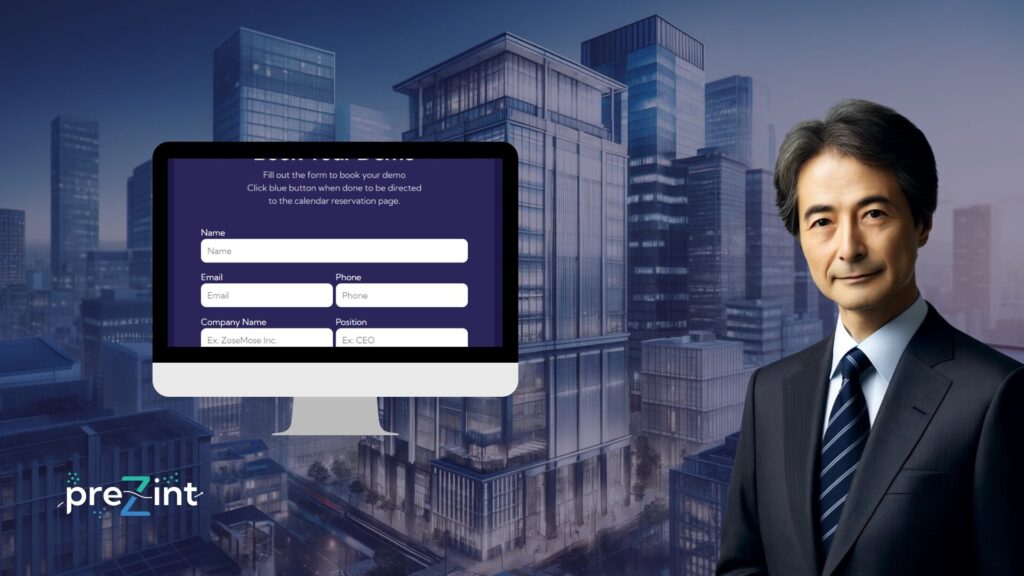
Scheduling
After questionnaire, reserve a date / time for demo.
Demo is held at your office or desired location
Benefit: See preZint live in person
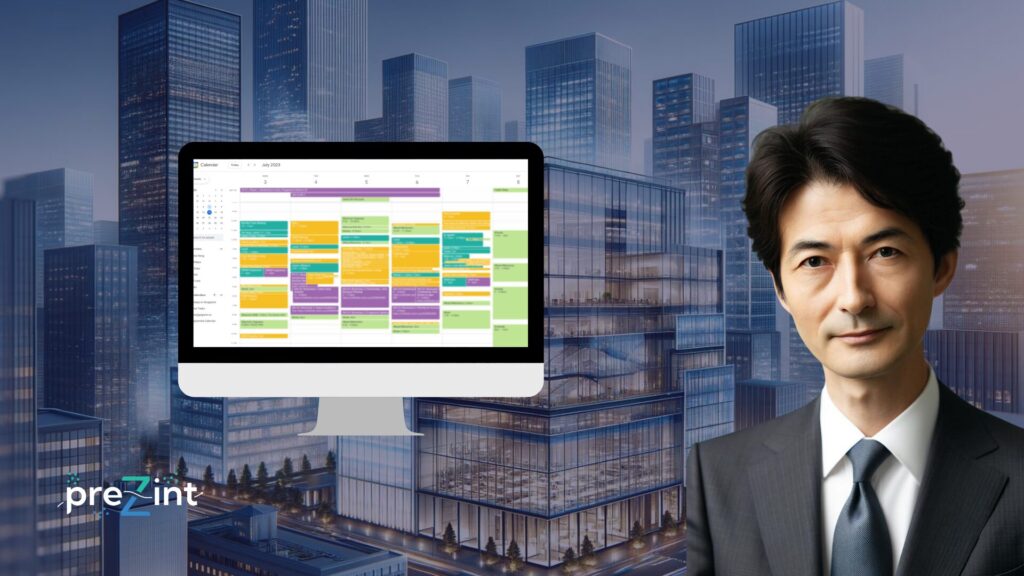
Live Demonstration
A sales representative & our expert will conduct a live demo at your desired location
Benefit: See for you industry how preZint can reduce operational costs by 30%


Book Your Demo
Fill out the form to book your demo
Click green button when done to be directed
to the calendar reservation page.
Your privacy is of our upmost concern. We will not share your information with any third parties. You can request that we delete your information at anytime.
Demo Is
What?
Your demo is the next step creating your customized preZint solution.
Below are some of the key points of the demo.
Below are some of the key points of the demo.
Questionnaire
Complete a questionnaire to understand
your companies specific & unique challenges
your companies specific & unique challenges
Benefit: Tailored insights to ensure
your demo addresses your exact needs
your demo addresses your exact needs


Scheduling
After questionnaire, reserve a date / time for demo.
Demo is held at your office or desired location
Demo is held at your office or desired location
Benefit: See preZint live in person
Live Demonstration
A sales representative & product specialist
will conduct a live demo at your desired location
will conduct a live demo at your desired location
Benefit: See for you industry how preZint
can reduce operational costs by 30%
can reduce operational costs by 30%

